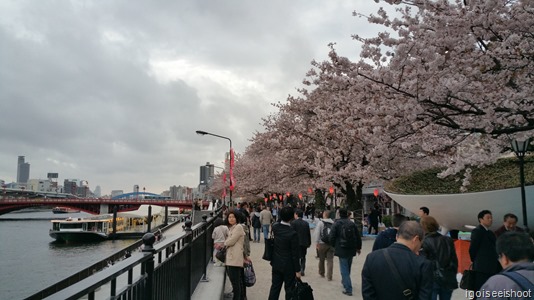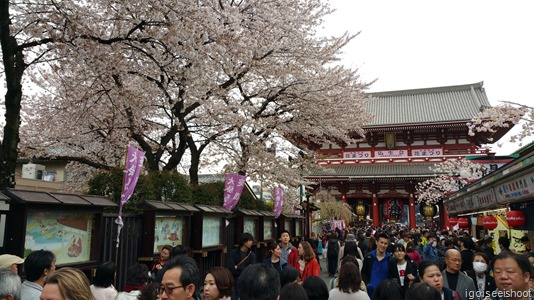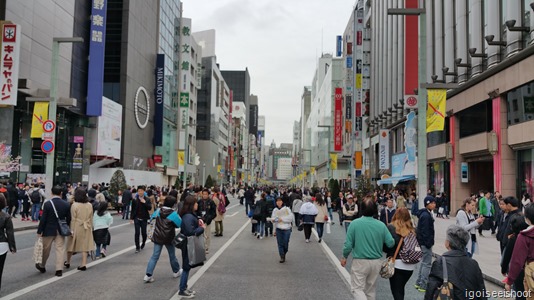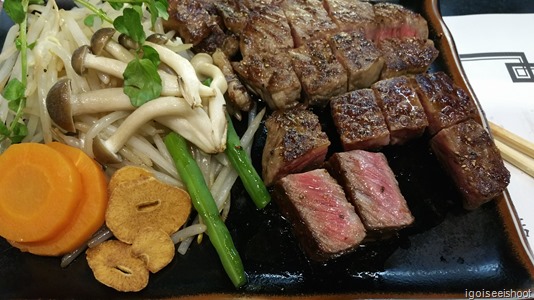April is a good time to visit Japan as it coincides with the cherry blossom season. However, during the expected Sakura season, air tickets are not cheap and hotel room rates could go double or even triple. And the cheaper and better rooms get sold out pretty quickly during this time as many tourists and even locals travels to the popular cherry blossoms viewing sites.

It is a good idea to check the Japan Cherry Blossom forecast websites when planning the itinerary. The cherry blossom or Sakura season in Japan is about a week and it could starts and ends earlier or later than forecasted, depending on the weather for the year. So, it was a case of planning the trip and hoping for the best.
Excellent Japanese food is not to be missed while travelling in Japan. Although one could find Japanese restaurants back home, the best Japanese food is obviously found nowhere else but in Japan.
During my trip planning, besides deciding on where to go, what to see and where to stay, it made sense to do some research on the best places to enjoy the best wagyu beef, ramen, tonkatsu, etc. while in Tokyo.
The following is the itinerary of our 9 days trip to Tokyo in April 2015, including a 3 days side trip to Hakone and Kawaguchiko to enjoy hot springs baths (onsens) at ryokans and see Mount Fuji.
Day 1 (2 April 2015)
Travel from home to Narita Airport, arriving in the evening.
Travel by bus to Tokyo Station.
There are many ways to get to Tokyo station. I took the Access Narita Bus instead of the trains since the bus station at Tokyo Station is nearest to my hotel compared to the train platforms in the massive and confusing Tokyo Station. The bus is also the cheapest option – 1000 Yen (just pay in cash on the bus.). The journey took 1 hour 30 minutes.

Spend the evening at Chidorigafuchi Park, one of the best places to view cherry blossoms in Tokyo at night.
Where I Stayed: APA Hotel Ginza Kyobashi, within walking distance to Tokyo Station and near to Kyobashi subway station. Although its location at Ginza is excellent, this is not a value-for-money hotel in my opinion. I did my hotel bookings “quite late” (one and half months before travel!) and there was not much choices left.
Trip report – Cherry Blossoms at Yasukuni Shrine and Chidorigafuchi Park.
Day 2 (3 April 2015)
Take subway from Kyobashi station to Okachimachi Station. Walk along Ameyoko shopping street. This street runs from Okachimachi to Ueno Station and is an lively open market along the railway tracks.
Go to Ueno Park to see cherry blossoms.
Thereafter, take the subway from Ueno station to Asakusa Station. See Asakusa temple and Nakamise street.

In the evening, walk from Asakusa to Sumida Park and River, one of the best 100 Sakura Spots in Japan. There are about 1000 Sakura planted along with the riverside. During the Hanami period which is between end of March to middle of April, there are a lot of ceremonies or events, such as traditional dance, music or Nursery rhyme song. Also, there many Yatai which sell food, toys or snacks during this time.
For dinner, try the famous Kobe Beef at the popular Gyu-an Restaurant in Ginza district.
Where I Stayed: APA Hotel Ginza Kyobashi, within walking distance to Tokyo Station and near to Kyobashi subway station.
Trip report - Cherry Blossoms Viewing at Ueno Park.
Trip report - Asakusa Temple and Nakamise Street.
Trip report - Cherry Blossom Viewing at Sumida Park and Kobe Beef dinner at Gyu-an Restaurant in Ginza district.
Day 3 (4 April 2015)
Visit the famous Tsukiji Fish Market, located about 15 to 20 minutes’ walk from the APA GInza Kobashi hotel. Visit both the Outer and Inner Market and visit the Namiyoke Inari Shrine next to the market. “Namiyoke” means protection from the waves. Since the Edo period, the worshippers came to the shrine to pray for safe voyage, good luck and averting misfortune.
Tip: Go with an empty stomach and have the freshest seafood (sushi and sashimi) at the Outer Tsukiji Market.
After the morning visit to Tsukiji Market, walk to Ginza, Tokyo's most famous upmarket shopping, dining and entertainment district.

On weekends afternoon, the central Chuo Dori street was closed to automobile traffic and became a large pedestrian zone. The road closure took place from 12:00 to 17:00.
Akihabara was our next stop after Ginza. Akihabara is an interesting place with much to see, e.g. all sorts of electronic stores, “maid cafes” and a 7-storey building meant for adults only.
End the day with dinner at Tokyo Station’s Ramen Street. It features Ramen stores operated by eight renowned names in Tokyo ramen.
Where I Stayed: APA Hotel Ginza Kyobashi, within walking distance to Tokyo Station and near to Kyobashi subway station.
Trip report - Tsukiji Fish Market and Namiyoke Inari Shrine.
Day 4 (5 April 2015)
Go to Shibuya and experience walking across the famous intersection outside the Shibuya Station. Dog lovers should not miss seeing the Hachiko statue at the entrance of the Shibuya Station too. There are also plenty to keep the shopaholics busy.
From Shibuya, head northwards to Harajuku. On most Sunday, Harajuku would be teeming with teens engaging in cosplay. More shoppings for the shopaholics at Takeshita Dori (Takeshita Street).
From the end of Takeshita Street, walk into Omotesando Hills. Omotesando is a broad, one kilometer long, tree lined avenue that is referred to as Tokyo's Champs-Elysees.
Eat at one of the best restaurants serving Tonkatsu (breaded, deep-fried pork cutlet) in Tokyo. The Maisen restaurant is a few hundred meters off the main Omotesando avenue, on a small street.
Where I Stayed: APA Hotel Ginza Kyobashi, within walking distance to Tokyo Station and near to Kyobashi subway station.
Trip report - Wandering around Shibuya, Harajuku, Omotesando and Chidorigafuchi Park at night.
Day 5 (6 April 2015)
After staying 4 nights at APA Hotel Ginza Kyobashi, we shifted to a hotel near Shinjuku Station.
After settling into our new hotel at Shinjuku, we took a JR train to Kichijoji to have Matsuzaka beef at a steakhouse, called Beef Satou. Matsuzaka Beef comes from the Matsuzaka region, and is consider the top brand of beef in Japan, alongside Kobe beef.

Opening hours for the restaurant.
Lunch: 11:00 am - 03:00 pm;
Dinner: 05:00 pm - 09:00 pm.
Try to arrive before opening time to avoid queue.
After lunch, check out the cherry blossoms at the nearby Inokashira Park.

Return to Tokyo by JR train and visit the Meiji Shrine, located within Yoyogi Park. The entrance to the park is next to the Harajuku Station.
Where I Stayed: Hotel Sunroute Plaza Shinjuku at Shinjuku, within walking distance to Shinjuku Station. Shinjuku is a good place to stay before and after our side trip to Hakone.
Trip report - Eating the famous Matsuzaka Beef at Steakhouse Satou.
Trip report – Cherry blossoms at Inokashira Park in Kichijoji.
Trip report - Visit to Meiji Shrine in Tokyo.
Day 6 (7 April 2015)
Make a 2 days side trip to Hakone and Kawaguchiko area (to see Mount Fuji and try the onsens) and then come back to Shinjuku again.
Travel by Odakyu Railways from Shinjuku Station to Hakone-Yumoto Station.
Do the Hakone model sightseeing course.

This round course starts and ends in Hakone-Yumoto and circles the Hakone region in the counter-clockwise direction with five different means of transport (train, cable car, ropeway, boat and bus), using the Hakone Free Pass or 3 Day Fuji Hakone Pass.
End the day with a delicious kaiseki dinner at the ryokan and a soak in the private hot spring bath (onsen).

Where I Stayed: Hakone Yumoto Onsen Pax Yoshino ryokan at Hakone. It is within walking distance to the Hakone Yumoto station, and also provides free shuttle bus services to and from the station.
The Japanese style rooms has bath that uses natural hot spring water. Some rooms have semi open-air bath with artistic Japanese cypress bath tub and guests could enjoy hot spring bathing (onsen) in an open environment with mountains and river in front of you. Chartered private hot spring (onsen) are also available and requires a reservation at check-in.
Trip report - Hakone and Kawaguchiko side trip from Tokyo – Day 1.
Day 7 (8 April 2015)
Travel by public bus from Hakone-Yumoto Station to the Lake Kawaguchiko area. There are 5 lakes around Mount Fuji. Lake Kawaguchiko is one the best. Visit the Gotemba Premium Outlet mall that is conveniently located on the way.
Must try local dish at Kawaguchiko: Houtou noodles. A recommended restaurant serving this is located just across the Kawaguchiko Station.


Spend the rest of the day enjoying the facilities of the luxury ryokan and/or enjoy views of the Mount Fuji at Kawaguchiko.
Where I Stayed: Kozantei Ubuya ryokan at Lake Kawaguchiko area. Kozantei Ubuya is one of the best ryokans located on the northern part of Lake Kawaguchiko that offers good views of Mount Fuji across the lake. Along this stretch of the shore, quite a lot of cherry tree were planted and this is one of the best spot to photograph the cherry blossoms with the lake and Mount Fuji in the background. We could call the hotel to arrange for free car pickup from the Kawaguchiko station.
Trip report - Hakone and Kawaguchiko side trip from Tokyo – Day 2.
Day 8 (9 April 2015)

Cherry blossom trees in bloom along the scenic lakeside path at Lake Kawaguchi.
Morning walk along lake and sightseeing around Lake Kawaguchi until time to leave for Shinjuku in Tokyo by the highway bus.
Tip: Book your seats on the bus online even though the fare were already included in Fuji Hakone Pass.
End the day free and easy around Shinjuku area and try more of the excellent Japanese cuisine. There are many eateries and restaurants around Shinjuku area.
Where I Stayed: Hotel Sunroute Plaza Shinjuku at Shinjuku, within walking distance to Shinjuku Expressway Bus Terminal and Shinjuku Station. This hotel is also a pick-up point for the airport limousine bus.
Trip report - Hakone and Kawaguchiko side trip from Tokyo – Day 3.
Day 9 (10 April 2015)
Free and easy around Shinjuku, till it was time to head for the airport.
Tip: Stop by Hotel Gracery Shinjuku if you are a fan of Godzilla.
We took a relaxing airport limousine bus ride to Narita Airport from the doorstep of our hotel.
Trip report - Wandering around Shinjuku
Other trip planning tips:
1. Travel within Tokyo
Use the efficient public transportation system within Tokyo. Check out this mobile phone app: Tokyo Subway Navigation for Tourists is a free application officially provided by Tokyo Metro to enable users to search transfer information for the Tokyo Subway network (Tokyo Metro and Toei Subway).
Buy the Suica or Pasmo IC cards or rechargeable cards from any ticket machines. These cards can be used to conveniently pay fares on public transportation and to make payments at a rapidly increasing number of vending machines, shops and restaurants by simply touching the card on a reader for about one second. I found this is most convenient when travelling by the subway within Tokyo as I don’t have to figure out the fares and buy a ticket every time I take the public transport. Just tap and go.
Note however that many airport limousine buses and most highway buses cannot be paid by IC card.
2. Side trip from Tokyo to Hakone and Kawaguchiko
It made sense to buy the 3 day Fuji Hakone Pass to save some money and also for convenience. The Fuji Hakone Pass is a rail pass for exclusive use by non-Japanese passport holders.
This tourist ticket is sold only at the Odakyu Sightseeing Service Centers at Shinjuku Station. The pass costs 7,400 Yen. (Update August 2017: it costs 8000 yen now).
It consists of:
- A round trip to the Mount Fuji Region by Odakyu Railways and Fujikyu/Keio highway bus. All seats reserved. Prior reservation required. You need to pay an additional Express fare to take the Odakyu Limited Express train called the "Romancecar".
- Unlimited use of buses, trains, boats, cable car and ropeway in the area around Hakone and the Fuji Five Lakes on three consecutive days.
- Discounted admission to selected tourist attractions.
The camera-shy Mount Fuji is often shrouded behind low clouds. If you could, choose to go Hakone or Kawaguchiko only on days with clear weather. A friend of mine got a clear view of Mount Fuji only on her third visit to Kawaguchiko and Hakone!
If going to Hakone only, consider the Hakone Free Pass instead.
3. Wi-fi in Tokyo
Very few places offer free Wi-Fi. Get a portable wi-fi device or buy Prepaid Data SIMs for use in my smartphone and use tethering to share with my travelling companions. Many plans are available at this econnect website.
4. Lastly, hotels in Tokyo.
I booked my hotels about 1.5 months before my travel dates and I found that only the more expensive rooms were available. I used Japanican to book my hotel rooms for this trip.
Rooms in Japanese hotels are very small by comparison to other countries and there are more smoking rooms than non-smoking rooms. Also, more single and twins rooms than doubles.
If I were to plan such a trip again, I would try to book as early as possible (with free cancellations at booking.com) to get the non-smoking rooms and also the rooms with large double beds.
Be careful about double beds. Some hotels market their super-single sized beds as small doubles! Booking.com specifies the room size as well as bed sizes, so you know what you are getting.
One of my main criteria for hotel is location. Preferably, within walking distance to transportation hubs like the Tokyo Station or Shinjuku Station (with airport trains, regional and local trains, buses) OR next to a subway/Metro station.
Alternatively, choose a hotel like the Hotel Sunroute Plaza Shinjuku where there are airport limousine bus services to Narita and Haneda Airport right outside the hotel. I think this is a good way to travel for those who travels with young children or do not wish to drag suitcases into the crowded Tokyo or Shinjuku train stations to take the Narita Express train.














 Ameyoko shopping street.
Ameyoko shopping street.













 Kaminarimon (Thunder Gate)
Kaminarimon (Thunder Gate)









